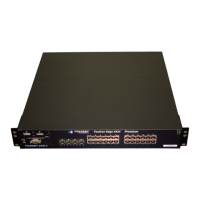Configuring Base Layer 3 and Enabling Routing Protocols
December 2005 © Foundry Networks, Inc. 5 - 3
NOTE: The clear arp command clears learned ARP entries but does not remove any static ARP entries.
Modifying and Displaying Layer 3 System Parameter Limits
You can configure the following Layer 3 system parameters:
• number of IP next hops and IP route entries
• number of hardware logical interfaces (physical port and VLAN pairs)
• number of output interfaces (clients)
These parameters are automatically enabled with pre-defined default values. You can however, adjust these
values to conform with your network’s topology.
To display the current settings for the Layer 3 system parameters, use the show default value command. See
“Displaying Layer 3 System Parameter Limits” on page 5-4.
To modify the default settings for the Layer 3 system parameters, use the system max command at the Global
CONFIG level of the CLI. See “Modifying Layer 3 System Parameter Limits” on page 5-3.
Configuration Note
Changing the system parameters reconfigures the device’s memory. Whenever you reconfigure the memory on a
Foundry device, you must save the change to the startup-config file, then reload the software to place the change
into effect.
Modifying Layer 3 System Parameter Limits
The Layer 3 system parameter limits share the same hardware memory space and, by default, consume all of the
hardware memory allocated for these Layer 3 limits. Therefore, to increase the limit for one of the parameters, you
must first decrease one or both of the other parameters’ limits. If you enter a value that exceeds the memory limit,
the CLI will display an error message and the configuration will not take effect.
For example, if the network topology has a smaller number of IP next hops and routes, but has numerous multicast
output interfaces, you could decrease the number of IP next hops and routes, then increase the number of
multicast output interfaces. To do so, enter commands such as the following:
FESX424 Router(config)# system-max hw-ip-next-hop 1024
FESX424 Router(config)# system-max hw-ip-mcast-mll 2048
FESX424 Router(config)# write mem
FESX424 Router(config)# reload
Likewise, if the network topology does not have a large number of VLANs, and the VLANs configured on physical
ports are not widely distributed, you could decrease the number of hardware logical interfaces, then increase the
number of IP next hops and multicast output interfaces. To do so, enter commands such as the following:
FESX424 Router(config)# system-max hw-logical-interface 2048
FESX424 Router(config)# system-max hw-ip-next-hop 3072
FESX424 Router(config)# system-max hw-ip-mcast-mll 2048
FESX424 Router(config)# write mem
FESX424 Router(config)# reload
Syntax: system max hw-ip-next-hop <num>
Syntax: system max hw-logical-interface <num>
Syntax: system max hw-ip-mcast-mll <num>
The hw-ip-next-hop <num> parameter specifies the maximum number of IP next hops and routes supported on
the device. Note that the maximum number includes unicast next hops and multicast route entries. Enter a
number from 100 to 6144. The default is 2048.

